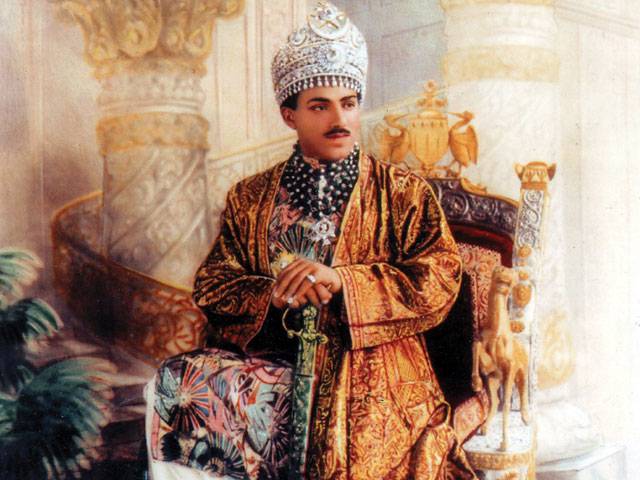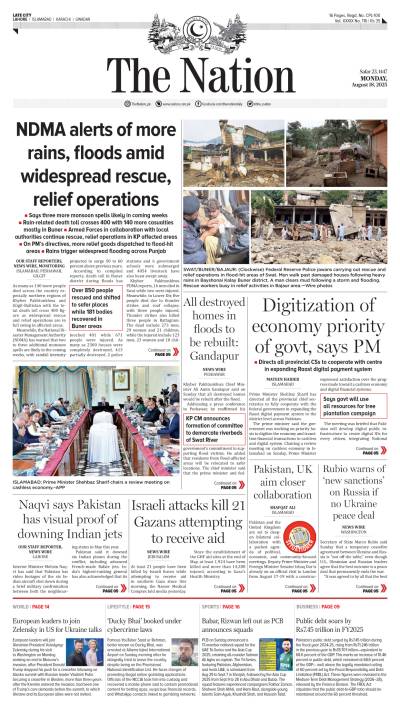BAHAWALPUR - Nawab Sadiq Muhammad Khan V, A great reformer and Mohsin-e-Pakistan was born in 1904. His father Nawab Muhammad Bahawal Khan Bahadur Abbasi died in 1907 and thus at an age of only three years, he became the ruler of the State of Bahawalpur. At the age of 8, he attended the Coronation Darbar in 1911 and commanded his State Imperial Service Camel Corps. From 1912-1914 he sojourned in England. He received his education from Aitcheson College Lahore during 1915-1920. He took his administrative training and course of military instruction at Quetta. In 1922 he received the rank of lieutenant and was attached to 21st King George’s Own Central India House. In 1924 he was invested the Knighthood of the star of India and in 1931 at Buckingham Palace, he received from his Imperial Majesty dignity of the G.C.I.E. In 1933 he was promoted to the rank of Major, in 1940 to Lt. Colonel and in 1946 to Major General. In 1923 he was made the President of Council of Regency. The council was abolished in 1924 and he took the reigns of the State of Bahawalpur.
His most important contribution was the Sutluj Valley Project that started in 1921. The project was to irrigate the Valley of Sutlej River. A pact was signed according to which three head works were built on the River Sutluj. As a result agricultural sector flourished leading to the prosperity of the people in the Bahawalpur region. Thenceforth the irrigation didn’t depend on wells and canals.
Nawab Sadiq took active part in the World War II that started in 1939. Apart from military help Nawab also gave financial assistance to the British Government. In May 1935 Quetta was jolted by a severe earthquake killing thousands of people. Those who survived were taken to Lahore by a daily train service. As this train used to reach Bahawalpur in the afternoons, Nawab ordered to give food, clothes and monetary help to the affected people and to supervise the arrangement; he himself daily visited the railway station.
Nawab Sir Sadiq was the only state ruler of Indo Pak subcontinent who initiated a revolution in a very short period of time though his broad vision in education, social and financial sectors, to adorn the state with prosperity and fertility. The impacts of these changes also influenced the Islamic world besides Indo Pak sub continent. He established a prosperous state with reference to the economic stability through Sutlej Valley Project. The annual fiscal budget of Bahawalpur State was more in volume than the current budget of Khyber Pakhtunkha province. Bahawalpur State possessed the status of a “Grain House” for Indo Pak sub continent due to the enormous agriculture produce.
The set up of a division of military force and desert rangers were extremely significant strategic and defensive measures for the protection of geographical boundaries. Bahawal Victoria Hospital at the time of its commencement used to provide free medical facilities not only to the state public, but also to the people of adjoining districts of British India, Baluchistan and Sindh.
Sir Sadiq Muhammad Khan V was greatly interested in the promotion of education and his passion was to adorn every native of the state with the light of education. In his efforts for the dissemination of education he readily spent the resources of the state and launched a number of educational institutions all over the state including the exclusive Sadiq Public School, Bahawalpur and when the first college of Bahawalpur, Sadiq Egerton College was founded, the college education was being provided only in Lahore and Delhi. In 1925 Jamia-e-Abbasia was inaugurated, which was equivalent to the Jamia Al Azher of Egypt. Even the existence of IUB is in itself bound in gratitude to His Highness, who extended glorifying services for the provision of the illumination of education to his masses. The founding of Sadiq Reading Library was also a proof of his passion for the knowledge. Sir Sadiq Muhammad Khan V also gave his financial patronage to the reputable academic institutions of India, Punjab University, Lahore, Muslim University, Aligarh, Nidvat-ul-Ulema, Lucknow and Jamia-e-Millia Delhi. Nwab Sadiq not only laid a network of educational institutions in the state but also extended financial help to the renowned academic institutions of British India. He gifted his private property to the University of the Punjab, King Edward Medical College and the Mosque of Acheson College, Lahore. His glorious and eminent services for the promotion of academic activities would be a beacon of light for the men in authority for the time to come. He spread the education on that time when the educational facility was not available in most of the British India.
He also focused his special attention on the health sector and established six major hospitals in the State for free medical treatment and supply of medicines to the ailing humanity. He also instituted judiciary, treasury and administrative departments during his rule and set a model for other princely states of India.
Bahawalpur State actually became the cause of the Pakistan’s coming into being, because this state extended sacrifices for the stability of Pakistan which are mentioned in the history with golden words. After partition Nawab proved to be very helpful and generous to the government of Pakistan. He gave seventy million rupees to the government and the salaries of all the government departments for six months were also drawn from the treasury of Bahawalpur State. He gifted his private property “Al Shamus Palace” at Malir Karachi to the First Governor General House. He also sends his Rules Rice Car and Body Gaurds for the reception of Governor General Muhammad Ali Jinnah.
At the time of partition all the princely states of the subcontinent were given a choice to join either Pakistan or India. For convincing Nawab to join India, Pandit Nehru went to him while he was in London and offered various incentives in this regard but he didn’t accept them. On this eve he said following historical words which was written in the history as a golden words.
“Pakistan is my Front door and India is my back door.Every Gentleman would like to use his front door not Back door “
On 5th October 1947 he signed an agreement with the government of Pakistan according to which Bahawalpur State joined Pakistan. Thus the State of Bahawalpur was the first state that joined Pakistan.
Moreover, Nawab and Quaid-i-Azam were close friends. This friendship was started when Nawab requested for some loan from the Indian government during the Sutluj River Project to lay down the terms and conditions of the loan an eminent lawyer M.A Jinnah was appointed. This was the beginning of the friendship between Quaid-i-Azam and the Nawab of Bahalpur and they had great respect for each other even before the creation of Pakistan. The Ameer of Bahawalpur Refugee Relief and Rehabilitation Fund were established in 1947 for providing a central organization for the relief of the refugees. The Quaid acknowledged the valuable contribution of the Bahawalpur State for the rehabilitation of the refugees. British Government gave 52000 Pond as a compensation of World War II which he gave this amount to Muhammad Ali Jinnah for the participation of Pakistan Muslim League in Election and for the welfare of Muslims.
Another contribution he made to the promotion and development of Urdu language in the State of Bahawalpur. After the laps of 67 years Urdu could not become our National Language but Nawab of Bahawalpur made this language as a National language before partition. At the time of partition, Bahawalpur State was called Mini Pakistan before partition. Urdu could not get the status of National language in Pakistan up till now but was the National language of Bahwalpur state before becoming Pakistan. It began to be used as the official language in the administrative work of the state. During his era the decisions of the High Court were also written in Urdu language. Islamic law could not be opted by the Government of Pakistan in last 65 years but was enforced in Bahawalpur State from hundreds of years.
Nawab Sir Sadiq Muhammad Khan V was a true follower of the Holy Prophet Hazrat Muhammad (SAW) and a faithful Muslim. Hence in this regard he not only patronized the religious seminaries in and out of state but also promoted the Islamic values in his State. It is also fact that the Mirzais were declared infidel during his reign by the Bahawalpur High Court in 1937.
He died in London on 24 May 1966 when he was only 61years old. He ruled over Bahawalpur for 59 years. He passed away from this world but he is still alive in the hearts of Muslims of the Sub-Continent.
May ALLAH give his soul in peace and rest? We should remember his remarkable services which were rendered by him for the Muslims of the world and pay him tribute as he deserved. Government of Pakistan should celebrate his day as a Mohsin-e- Pakistan day and declare gazzetted holiday.
On the eve of 47th death anniversary of Nawab of former Bahawalpur State‚ Sadiq Muhammad Khan Abbasi-V, Pakistan Postal Services issued a commemorative stamp.
Tuesday, August 19, 2025
Nawab Sadiq Muhammad Khan V, A great reformer and Mohsin-e-Pakistan

Digital Terrorism
August 19, 2025
Hague Group’s Proposals
August 19, 2025
Historical Amnesia
August 19, 2025
Mafia in Nathia Gali
August 19, 2025
Cost of Diplomatic Paralysis
August 19, 2025
-
'No talk of President Zardari resigning or COAS seeking Presidency': Naqvi rejects rumours
-
'No talk of President Zardari resigning or COAS seeking Presidency': Naqvi rejects rumours
-
Pilgrims perform final Hajj ritual as Eidul Azha begins amid tight security and heat measures
-
Hajj 2025 sermon: Imam-e-Kaaba prays for Palestine, urges unity and compassion
-
Nearly 2 million Muslim pilgrims ascend Mt Arafat for climax of Hajj pilgrimage
-
How the US repeatedly failed to deliver aid to the people of Gaza
Digital Leap
August 18, 2025
Unmasked Complicity
August 18, 2025
A New Kick-Off
August 18, 2025
Drowning in Denial
August 17, 2025
A Fragile Peace
August 17, 2025
Admissions Crisis in Punjab
August 18, 2025
Poultry Mafia
August 18, 2025
Prevention Over Cure
August 18, 2025
Olympics 2028
August 17, 2025
Alarming Rise in Youth Unemployment
August 17, 2025
ePaper - Nawaiwaqt
Nawaiwaqt Group | Copyright © 2025







